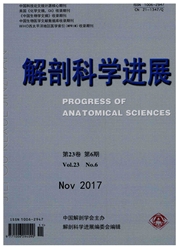

 中文摘要:
中文摘要:
目的探讨大鼠在创伤后应激障碍(posttraumatic stress disorder,PTSD)杏仁核学习记忆的变化。方法选择正常成年雄性wistar大鼠60只,随机均分为正常对照组和单一连续刺激(SPS)的6h,12h,1d,7d及14d组。应用电生理方法测量各组群体锋电位(population spike,PS)幅值;应用酶组织化学方法检测PTSD对乙酰胆碱酯酶(acetylcholine,AChE)的影响。结果与正常对照组PS幅值增强率(134.03±2.540)%相比,高频刺激后,早期杏仁核逐渐受到抑制,其中1d的变化最显著,PS幅值增强率(65.84±5.246)%降低最明显。7d时PS幅值增强率(152.41±11.125)%升至最高,以后逐渐恢复至正常。AChE活性SPS1d时升至最高,7d时降至最低,以后逐渐向正常恢复。结论创伤后应激障碍急性期大鼠杏仁核受抑制,学习记忆能力降低。
 英文摘要:
英文摘要:
Objective To study the change of expression of acetylcholine and long term potentiation (LTP) in amygdala of post-traumatic stress disorder (PTSD) rat. Method Sixty normal adult male Wistar rats were averagely randomized into: normal control group and single prolonged stress (SPS) groups(6h, 12h, ld, 7d and 14d ), using electrophysiology to measured the change of population spike (PS) amplitude and enzymohistochemistry to detect the expression of acetylcholinesterase (ACHE). Results Compared to control groups ( 134.03 ± 2.540% ) , the enchancement rate of PS amplitude (65.84 ±5.246%) was decreased obviously at ld after high-frenquency stimulation, but rose to the highest at 7d (152.41±11.125%) after high-frenquency stimulation, then gradually restored to normal. AChE activity increased to the maximum at ld and decreased to the minimum at 7d after high-frenquency stimulation, later gradually to normal. Conclusion The activity of amygdala was inhibited and the capacity of learning and memory decresed at the acute ohase of PTSD.
 同期刊论文项目
同期刊论文项目
 同项目期刊论文
同项目期刊论文
 Single-prolonged stress induces apoptosis in the amygdala in a rat model of post-traumatic stress di
Single-prolonged stress induces apoptosis in the amygdala in a rat model of post-traumatic stress di Activitity of the 5-HT 1A receptor is involved in the alteration of glucocorticoid receptor in hippo
Activitity of the 5-HT 1A receptor is involved in the alteration of glucocorticoid receptor in hippo Increased phosphorylation of extracellular signal-regulated kinase in the medial prefrontal cortex o
Increased phosphorylation of extracellular signal-regulated kinase in the medial prefrontal cortex o Changes of Bax, Bcl- 2 and apoptosis in hippocampus in the rat model of post-traumatic stress disord
Changes of Bax, Bcl- 2 and apoptosis in hippocampus in the rat model of post-traumatic stress disord 期刊信息
期刊信息
